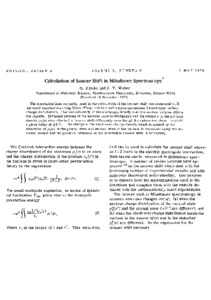Calculation of isomer shift in Mössbauer spectroscopy
| dc.date.accessioned | 2008-09-15T13:10:38Z | |
| dc.date.available | 2008-09-15T13:10:38Z | |
| dc.date.issued | 1972 | |
| dc.identifier.issn | 1098-0121 | |
| dc.identifier.issn | 0163-1829 | |
| dc.identifier.issn | 0556-2805 | |
| dc.identifier.uri | urn:nbn:de:hebis:34-2008091523798 | |
| dc.identifier.uri | http://hdl.handle.net/123456789/2008091523798 | |
| dc.format.extent | 425215 bytes | |
| dc.format.mimetype | application/pdf | |
| dc.language.iso | eng | |
| dc.rights | Urheberrechtlich geschützt | |
| dc.rights.uri | https://rightsstatements.org/page/InC/1.0/ | |
| dc.subject.ddc | 530 | |
| dc.title | Calculation of isomer shift in Mössbauer spectroscopy | eng |
| dc.type | Aufsatz | |
| dcterms.abstract | The approximations normally used in the calculation of the isomer shift are compared with the exact expressions using Dirac-Slater orbitals and a three-parameter Fermi-type nuclear charge distribution. The nonuniformity of the electronic density over the nuclear volume affects the results. Different choices of the nuclear surface thickness t and the radius c in the protonic density P_N (\gamma) also affects the isomer shift differently even though the values are chosen to yield a given value of \delta <r^2>. The change in the electronic charge density which is caused by the alteration of P_N (\gamma) in the ground state and excited state of the nucleus is discussed using two extrememodels and the possible influence on the observable isomer shift is estimated. | eng |
| dcterms.accessRights | open access | |
| dcterms.bibliographicCitation | In: Physical review / B. - Ridge, NY : APS, 5.1972, S. 3445 - 3449 | |
| dcterms.creator | Fricke, Burkhard | |
| dcterms.creator | Waber, James Thomas | |
| dc.description.et | Extern | ger |
Files in this item
This item appears in the following Collection(s)
-
Publikationen [132]

